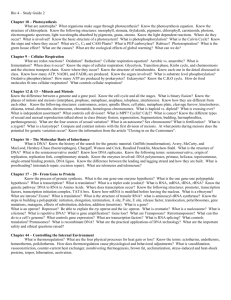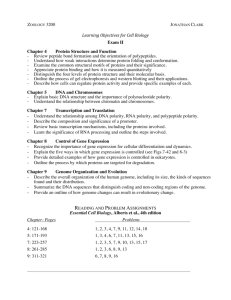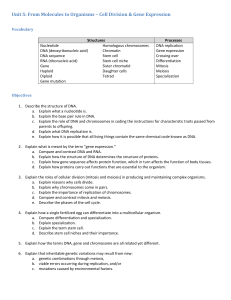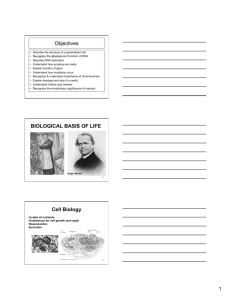BIOL 160 Final Exam Study Guide
advertisement
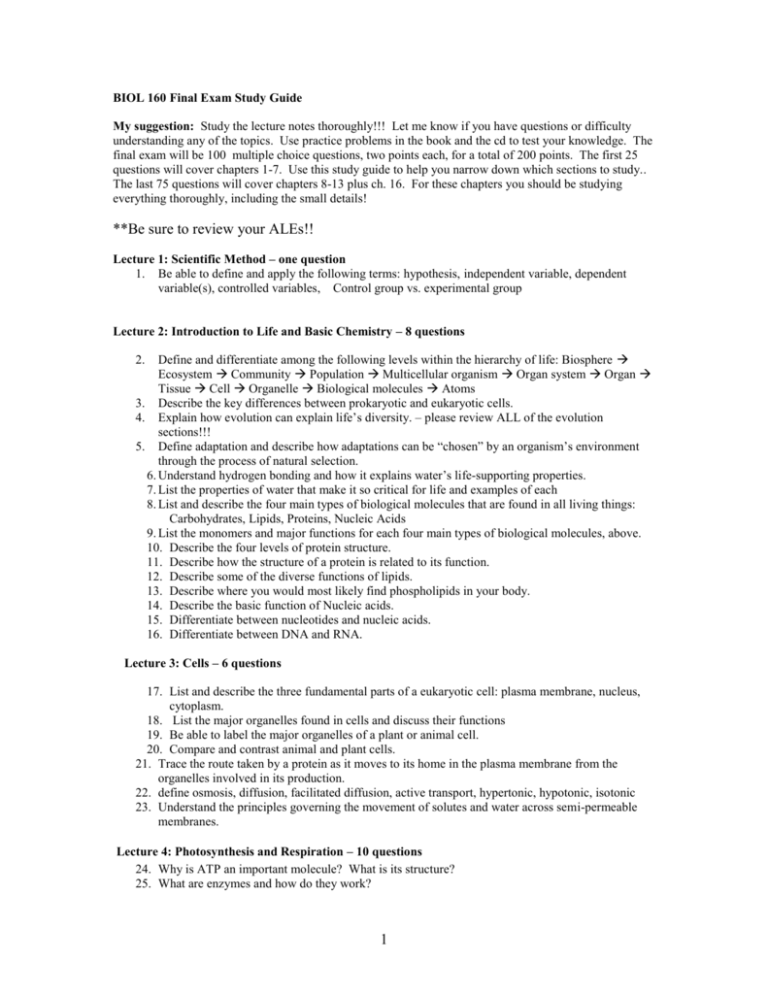
BIOL 160 Final Exam Study Guide My suggestion: Study the lecture notes thoroughly!!! Let me know if you have questions or difficulty understanding any of the topics. Use practice problems in the book and the cd to test your knowledge. The final exam will be 100 multiple choice questions, two points each, for a total of 200 points. The first 25 questions will cover chapters 1-7. Use this study guide to help you narrow down which sections to study.. The last 75 questions will cover chapters 8-13 plus ch. 16. For these chapters you should be studying everything thoroughly, including the small details! **Be sure to review your ALEs!! Lecture 1: Scientific Method – one question 1. Be able to define and apply the following terms: hypothesis, independent variable, dependent variable(s), controlled variables, Control group vs. experimental group Lecture 2: Introduction to Life and Basic Chemistry – 8 questions Define and differentiate among the following levels within the hierarchy of life: Biosphere Ecosystem Community Population Multicellular organism Organ system Organ Tissue Cell Organelle Biological molecules Atoms 3. Describe the key differences between prokaryotic and eukaryotic cells. 4. Explain how evolution can explain life’s diversity. – please review ALL of the evolution sections!!! 5. Define adaptation and describe how adaptations can be “chosen” by an organism’s environment through the process of natural selection. 6. Understand hydrogen bonding and how it explains water’s life-supporting properties. 7. List the properties of water that make it so critical for life and examples of each 8. List and describe the four main types of biological molecules that are found in all living things: Carbohydrates, Lipids, Proteins, Nucleic Acids 9. List the monomers and major functions for each four main types of biological molecules, above. 10. Describe the four levels of protein structure. 11. Describe how the structure of a protein is related to its function. 12. Describe some of the diverse functions of lipids. 13. Describe where you would most likely find phospholipids in your body. 14. Describe the basic function of Nucleic acids. 15. Differentiate between nucleotides and nucleic acids. 16. Differentiate between DNA and RNA. 2. Lecture 3: Cells – 6 questions 17. List and describe the three fundamental parts of a eukaryotic cell: plasma membrane, nucleus, cytoplasm. 18. List the major organelles found in cells and discuss their functions 19. Be able to label the major organelles of a plant or animal cell. 20. Compare and contrast animal and plant cells. 21. Trace the route taken by a protein as it moves to its home in the plasma membrane from the organelles involved in its production. 22. define osmosis, diffusion, facilitated diffusion, active transport, hypertonic, hypotonic, isotonic 23. Understand the principles governing the movement of solutes and water across semi-permeable membranes. Lecture 4: Photosynthesis and Respiration – 10 questions 24. Why is ATP an important molecule? What is its structure? 25. What are enzymes and how do they work? 1 26. Photosynthesis a. where does it occur b. definition c. reactants, products d. basic steps of the light reactions & Calvin cycle 27. Cellular respiration a. where does it occur b. definition c. 3 steps of aerobic respiration d. anaerobic respiration – 2 steps 28. Explain the greenhouse effect Lecture 5: The cell cycle and cell division – 18 questions 29. Differentiate between mitosis and meiosis with regard to where they occur and what they produce. 30. List and discuss several reasons why it is important that your body cells can divide and make more cells. 31. Describe the main events of the cell cycle. 32. Differentiate between G1, S, and G2 of the cell cycle. 33. Differentiate between Interphase, mitosis and cytokinesis. 34. List the stages of mitosis and describe the main events that occur in each step. 35. Describe the various methods of cancer treatments and how they work. 36. Explain why cancer treatments may cause some or all of the following: hair loss, nausea, anemia, depressed immune response, wounds heal slowly, increased rate of infection, general weakness, depressed ability of the body to attack and kill cancer cells. 37. Describe the roles of each of the following in controlling cell division: Growth factors, growth factor receptors, proto-oncogenes, oncogenes, tumor suppressor genes, p53 gene, BRCA 1 gene 38. List the three major environmental factors that cause mutations that can lead to cancer. 39. List the major characteristics of cancer cells. 40. Be able to answer the following three questions: 1.) What is cancer?, 2.) How are cancerous cells different than normal cells?, 3.) How do you get cancer? 41. Describe how many chromosomes are in the haploid and diploid cells of humans. 42. Explain why two sequential cell divisions (meiosis I and II) are necessary to change a cell from the diploid to the haploid state. 43. Differentiate between the alignment of the chromosomes during metaphase of mitosis, metaphase I of meiosis, and metaphase II of meiosis. 44. Differentiate between how chromosomes or chromatids separate during anaphase of mitosis, anaphase I of meiosis and anaphase II of meiosis. 45. Describe how nondisjunction of chromosomes during anaphase I of meiosis can lead to a child with Down syndrome. 46. Explain why Down syndrome is linked to the age of the mother and has little relationship to the age of the father. 47. Describe crossing-over during prophase I of meiosis and how it leads to genetic differences in gametes. 48. Describe independent assortment and how it leads to genetic differences in gametes. Lecture 6: Mendelian Genetics – 13 questions 49. Differentiate between dominant and recessive traits. 50. Differentiate between parental (P), first filial (F1), and second filial (F2)generations. 51. Differentiate between genes and alleles, and locate these terms on homologous chromosomes. 52. Describe how many alleles are possible for each gene in an individual and how many alleles are possible for each gene in a population. 53. Distinguish between phenotype and genotype. 54. Describe Mendel’s law of segregation. What connection does it have with the alleles that are on homologous chromosomes? 55. Describe Mendel’s law of independent assortment 2 56. Distinguish between a person that is a carrier of a recessive trait and a person that is affected by a recessive trait like cystic fibrosis. 57. Interpret a human pedigree chart involving a recessive trait and determine the genotype of all individuals in the pedigree. 58. Using AA, Aa, or aa, determine the genotype of individuals if they were carriers of a recessively inherited trait. 59. Describe why the inheritance of sickle cell anemia is considered incomplete dominance. 60. Differentiate between codominance and incomplete dominance. 61. Solve genetics problems involving the inheritance of the ABO blood groups and Rh-factor. 62. Defend the following statement: Although each individual can only have two alleles for each gene, a population (i.e. population’s gene pool) may have several alleles per gene. 63. Describe how independent assortment can lead to the formation of gametes with different genotypes. 64. Diagram a dihybrid cross between two individuals who are heterozygous for each trait and explain the importance of the 9:3:3:1 ratio that results. 65. Describe the connection between Mendel’s principle of independent assortment and what happens to the chromosomes during metaphase I of meiosis with the way the homologous chromosomes align along the midline of the cell. 66. Differentiate between sex chromosomes and autosomes in males and females. 67. Give examples of sex-linked traits and explain why females are more likely to be carriers of Xlinked traits than males, but males are more likely to suffer the effects of X-linked traits than females. 68. Illustrate how environmental factors can influence gene expression and phenotype. Lecture 7: DNA Replication, Transcription, Translation – 12 questions 78. List the differences between the nucleotides found in DNA and RNA. 79. Discuss how the hydrogen bonds holding together nucleotides in a DNA molecule contribute to its replication. 80. Describe the structure of DNA. 81. Explain what a gene is. 82. Explain/discuss the central dogma of biology: Genes interacting with the environment determine the phenotype of an organism. 83. Explain why DNA replication is necessary for the survival of all species. 84. During which phase of the cell cycle does DNA replication occur? 85. Describe the process of DNA replication and the roles played by each of the following: DNA polymerase, DNA nucleotides. 86. Briefly describe the processes of transcription and translation. 87. Explain why an RNA molecule is shorter than the DNA template from which it was transcribed. 88. Compare and contrast DNA and RNA. 89. Describe the role of the promoter in transcription. 90. Explain how transcription differs from replication. 91. Discuss how nucleotides are added to the growing RNA molecule during transcription and the role played by RNA polymerase. 92. List the two types of RNA produced by transcription and describe their roles in protein synthesis. 93. Make a sketch of a model of tRNA and label the anticodon. 94. Describe the relationship between codons, anticodons, mRNA, tRNA, amino acids and ribosomes, and the roles played by each during protein synthesis. 95. Describe each of the following steps of protein synthesis: initiation, elongation, and termination 96. Compare and contrast base substitution mutations and base deletions and base insertions. 97. Discuss the causes of mutations, when they occur and why they are usually harmful, but occasionally beneficial. 98. Explain the evolutionary significance of mutations. 3 99. Given the nucleotide sequence in a gene and a table of codons, write the resulting mRNA nucleotide sequence if the gene were to be transcribed and the amino acid sequence if the mRNA were to be translated to protein. Cystic Fibrosis 100. Describe the role played by the CFTR protein in cells lining the lungs and ducts in the human body. 101. Describe the phenotype (symptoms) of a person with cystic fibrosis. 102. Explain the symptoms of cystic fibrosis—that is, explain why a faulty CFTR protein causes all the symptoms associated with CF. Lecture 8: Gene Regulation. & DNA Technology – 20 questions 103. describe DNA packaging, including the following terms: histones, nucleosomes, tight helical fibers, supercoils describe x chromosome inactivation explain the role of regulatory proteins such as transcription factors, activators, and silencers in regulation of gene expression 106. explain the role of regulatory sequences such as promoters and enhancers in regulation of gene expression 107. explain how alternate RNA splicing can create multiple protein types from one gene 108. explain RNAi and how it affects gene expression 109. explain epigenetic inheritance and how it is accomplished 110. explain the 3 steps of signal transduction 111. describe the process of cloning 112. explain the difference between reproductive and therapeutic cloning 113. explain the 3 steps of DNA profiling, including the steps of PCR 114. explain how short tandem repeats are used in DNA profiling 115. explain the role of bacterial plasmids in recombinant DNA technology 116. describe the pros and cons of genetically modified organisms 117. explain how gene therapy works 104. 105. Lecture 9: Evolution of populations and prokaryotes – 14 questions 118. review all basic concepts of Darwin’s theory of evolution 119. review the evidence for evolution, including fossils, comparative anatomy, comparative embryology, and molecular biology 120. define gene pool and microevolution 121. explain each of the three main causes of microevolution: natural selection, genetic drift, and gene flow. 122. explain the bottleneck effect and found effect 123. differentiate between the three types of natural selection 124. define photoautotrophs, chemoautotrophs, photoheterotrophs, and chemoheterotrophs 125. describe the typical habitat of an organism from the domain Archaea. 126. define bioremediation 127. explain the endosymbiotic hypothesis for the evolution of eukaryotes 4


